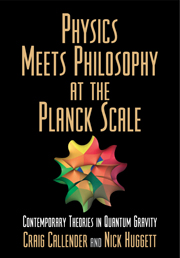Book contents
- Frontmatter
- Contents
- Preface
- 1 Introduction
- Part I Theories of Quantum Gravity and their Philosophical Dimensions
- Part II Strings
- Part III Topological Quantum Field Theory
- Part IV Quantum Gravity and the Interpretation of General Relativity
- Part V Quantum Gravity and the Interpretation of Quantum Mechanics
- References
- Notes on contributors
- Index
1 - Introduction
Published online by Cambridge University Press: 15 December 2009
- Frontmatter
- Contents
- Preface
- 1 Introduction
- Part I Theories of Quantum Gravity and their Philosophical Dimensions
- Part II Strings
- Part III Topological Quantum Field Theory
- Part IV Quantum Gravity and the Interpretation of General Relativity
- Part V Quantum Gravity and the Interpretation of Quantum Mechanics
- References
- Notes on contributors
- Index
Summary
In recent years it has sometimes been difficult to distinguish between articles in quantum gravity journals and articles in philosophy journals. It is not uncommon for physics journals such as Physical Review D, General Relativity and Gravitation and others to contain discussion of philosophers such as Parmenides, Aristotle, Leibniz, and Reichenbach; meanwhile, Philosophy of Science, British Journal for the Philosophy of Science and others now contain papers on the emergence of spacetime, the problem of time in quantum gravity, the meaning of general covariance, etc. At various academic conferences on quantum gravity one often finds philosophers at physicists' gatherings and physicists at philosophers' gatherings. While we exaggerate a little, there is in recent years a definite trend of increased communication (even collaboration) between physicists working in quantum gravity and philosophers of science. What explains this trend?
Part of the reason for the connection between these two fields is no doubt negative: to date, there is no recognized experimental evidence of characteristically quantum gravitational effects. As a consequence, physicists building a theory of quantum gravity are left without direct guidance from empirical findings. In attempting to build such a theory almost from first principles it is not surprising that physicists should turn to theoretical issues overlapping those studied by philosophers.
But there is also a more positive reason for the connection between quantum gravity and philosophy: many of the issues arising in quantum gravity are genuinely philosophical in nature.
- Type
- Chapter
- Information
- Physics Meets Philosophy at the Planck ScaleContemporary Theories in Quantum Gravity, pp. 1 - 30Publisher: Cambridge University PressPrint publication year: 2001
- 3
- Cited by



